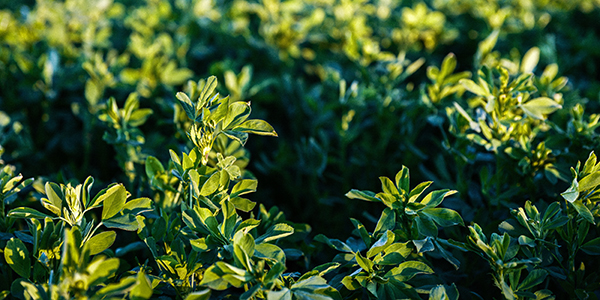AGRONOMICSUPPORT
YOU CAN TAKETO THE FIELD
Fall Alfalfa Management
Signs that fall is coming are everywhere. The days are getting shorter, the foxtail is aggressively trying to put on seed heads, kids are back in school, I hate to be the bearer of bad news, but it is time to think about getting ready for winter!

If you are an alfalfa producer, that means managing your stand to get the best winter survival and the most out of next year’s crop.
To cut or not to cut is often the question. If you evaluate the stand and decide you aren’t going to let it go another year, the answer is easy - cut whenever you want to. For the stands you are going to keep, the decision can be more difficult. It is important to give a high-producing stand a five- to six-week “rest” in the fall. This allows the crown roots to build up carbohydrates that will be used as energy to make it through the winter. In my area of central Wisconsin, this usually means avoiding cutting between September 1st and October 15th.
If you are short on forage and would like to take another cutting, it is important to wait not just until after the first frost, but until at least two nights in a row of 25 degrees or lower. If you decide to cut, leave more stubble (4-6”), and I would also recommend leaving strips of uncut alfalfa to “catch” more snow, especially in larger open fields. The best thing for vigor and winter survival of the stand is to not cut it at all after early September.
Fall fertilization is just as important to alfalfa winter survival as cutting management. The most important nutrient for winter survival is potassium. Potassium is important for the movement of sugars, making sugars or photosynthesis, and water relations. Long story short, more sugars moving more efficiently through the plant leads to high yields and better winter survival. It is important to split apply your K needs usually after first cutting and right after the last harvest before the “rest” period.
Fall is also a good time to think about the field you plan to seed two years out. This allows you to take soil tests and make sure you get your pH, phosphorus, and potassium levels up to snuff, well before the seeding year. This will improve stand establishment and productivity.
Note: The information in this issue is based upon field observations and third-party information. Since variations in local conditions may affect the information and suggestions contained in this issue, LG Seeds disclaims legal responsibility therefore. Always read and follow label instructions.
Advantage Acre, LG Seeds and design are trademarks of AgReliant Genetics, LLC.






Technical Team Agronomist